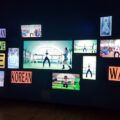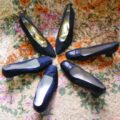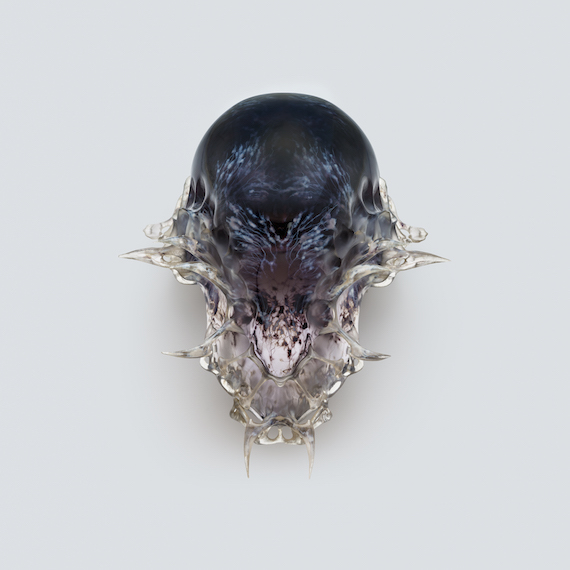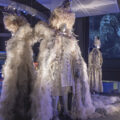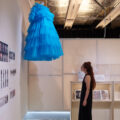Review – The Fabric of Democracy: Propaganda Textiles from the French Revolution to Brexit
March 10, 2024Fabric of Democracy Review. This show, curated by Amber Butchart, is clever and thoughtful. Even the title is witty, and this sets the tone for the whole exhibition.
Propaganda is a dirty word, isn’t it, implying underhand tactics to persuade (brainwash?) us into something distasteful – it’s most often paired with the word N*zi, as in N*zi Propaganda. However, propaganda has been used on all sides in all wars, whichever you think of as the “Good” side. It is also used in advertising and by anyone who has a cause close to their heart. But as this exhibition shows, Joseph Goebbels didn’t invent it. The Bayeux Tapestry, celebrating the Norman Conquest of England, is a far earlier example, to name just one.
The Storming of the Bastille, in Toile de Jouy
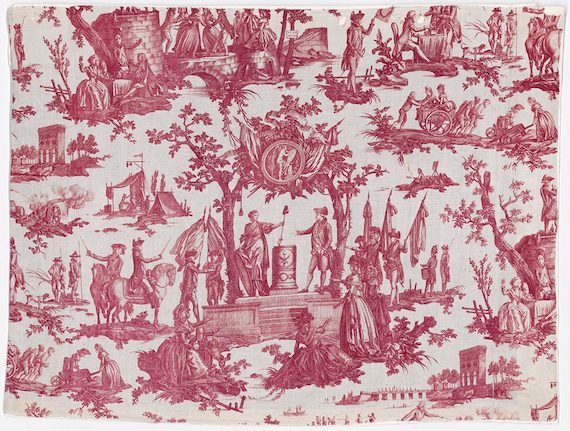
La Fête de la Fédération textile, 1790. Credit Musee de la Toile de Jouy. Fabric of Democracy review.Used with permission.
And the French Revolution is another. Somehow, when a red and white Toile de Jouy is printed with scenes depicting crinolined ladies dancing in a circle with men in breeches, and handing them triumphant flags, as in the fabric La fete de la Federation from 1790, it looks charming, and not sinister. It actually celebrates the storming of the Bastille. Similarly a blue, cream and pink silk scarf from 1938 loosely illustrated with marching platoons of soldiers and gas masks seems quite fun, and a nice symbol of support. I suppose it is because such quaint artefacts can’t help bringing to mind the kind of mild provincial ladies who might wear these kinds of fabrics, and conclude that the effect is, after all, rather harmless.
But this conclusion is very loaded, and a big mistake, as Butchart explains. “Textiles have been heavily feminised in the west throughout history, as women’s work – people tend to view them as somehow ephemeral and unimportant. I’d like people to reconsider that idea and think about how textiles have not only been an incredible important economic force throughout history, but as political objects in themselves,” she said.
Fabric of Democracy Review – Carefully Considered Exhibition

A version of a Jacqmar Scarf about saving rubber. Copyright Imperil War Museum, used with permission.
She has selected over 150 objects to convey her theme. It is a dense show, with a lot of information and points to ponder, divided into several sections. The first section looks at the traditional propaganda subjects of war and conflict. It includes European, North American, and East Asian objects. Later on, the celebration and critique of nationalism through textiles and commercial exploration of textiles is examined.
The feed sack dresses of 1930s America are a good example of the power of company propaganda. There are a lot of articles floating around the internet about this. Many Americans who are from rural locations particularly actually remember their parents or grandparents speaking about it too, in general in a very positive way. Even now this is often spun as an act of kindness by writers of these posts. The comments are full of how magnanimous the companies were to think of the women and children in these circumstances. The reality is that though it definitely had a positive outcome, it was a very, very, canny idea by whoever thought of it.
Two-For-One
The concept, shown here in the Fabric of Democracy Review was to print the rough cotton sacks that animal feed or seed came in with pretty dressmaking designs. The company logo and labelling was printed in an ink which washed out, while the decoration remained. A feed sack had a couple of metres of fabric in it, but was not very wide. Enough to make a child’s dress, or perhaps half of a woman’s. So you would have to buy two feedbacks of the same design.
The company who had the best designs took the edge over other farming supply companies, regardless of the quality of the contents. One imagines the maybe they could even be a little bit more expensive because the farmer is getting two for one. He buys feed for his animals and clothing for his household. This is a time when all clothing was made at home, and usually by the female members of the household. These poor families usually did not have enough money to spend on clothes.
Fabric of Democracy Review – Silk Scarves, Scattered all around
Other free things in times of hardship: Koreans dropped silk scarves for American servicemen to pick up. Obviously, the servicemen were not intended to be attracted to them for their own necks, but as valuable gifts for their sweethearts back home. And sure enough, they were printed with the words: “Those who love you want you back home safe and sound”. Which to be fair, they probably did. It reminds me of the tactic where you pick up a tenner on the road, but it turns out not to be a tenner, but an advert. Gets me very time.
Silk scarves being very fashionable in that period – in fact more of an essential part of the wardrobe than a fashion item – they existed in their millions and were of course used for propaganda on the home front. The exhibition features a WW2 scarf suggesting women salvage rubber – a not particularly glamorous motif. This is by Jacqmar, a brand who particularly specialised in these witty novelty prints. They were both expensive and sought after. And it was not just the British who thought outside the box. A Japanese kimono from around the same date is covered in tanks and fighter planes, harmoniously arranged within the overall design. I have seen novelty kimonos with spy pigeons and depicting other, more benign plane flights before. They were designed for boys, much like kids’ jumpers featuring dinosaurs and trains today.
Fabric of Democracy Review – An ongoing tale
But radical textiles do not belong in the past, nor do they stay there. Close to home, a jovial tea-towel proclaims that Boris Johnson “Got Brexit Done”. And there is an African kanga printed with Barak Obama’s head. We know very well that dress is powerful and this is another thoughtful aspect of that.
The Fabric of Democracy: Propaganda Textiles from the French Revolution to Brexit was at the Fashion and Textiles Museum.



